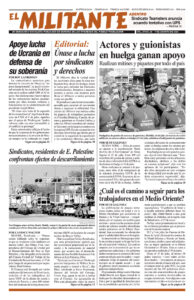LISBON, Ohio — Residents of this area around East Palestine, who continue to be affected by the toxic chemicals released by the Norfolk Southern derailment and burn-off Feb. 3, and rail workers across the country are continuing to fight for greater control over safety, cleanup and health care.
Forty protesters gathered here at the Columbiana County Seat July 22 to support residents in the area who still face health problems and other challenges almost six months since the derailment.
When Norfolk Southern bosses and area officials drained and burned some 900,000 pounds of toxic vinyl chloride after the derailment, “I watched the mushroom cloud from my porch,” Jess Conard told the crowd. “I’m active in this fight so that no one else will face another disaster like this.” Conard is a member of the Unity Council for the East Palestine Train Derailment, which helped build the rally. She wrote an article published in Newsweek last week that she quoted from.
“Biden, we demand that you sign the disaster declaration. And we demand that you enact 1881A,” she said. “Prioritize human beings. Prevent another East Palestine.”
1881A is a section of the Social Security Act that provides for lifelong medical care to those affected by a public health emergency. For it to be invoked, the president must first declare East Palestine an environmental disaster.
The Lisbon action was initiated by a group that pushes for Medicare for all. This action focused on East Palestine. Other groups participated, including activists from Illinois and Missouri.
After a monthslong campaign by the Unity Council, including a rally at the state Capitol, Ohio Gov. Mike DeWine sent a request to Washington July 3 urging President Joseph Biden to sign the disaster declaration.
“The government is owned by the railroad,” Jami Wallace, president of the Unity Council, told the rally. “Biden, this could happen anywhere that has railroads running through it.”
Jenna Cozza, Wallace’s 17-year-old niece, said she and her younger sister and brother have tested positive for vinyl chloride residue in their urine. Other area residents have similar results. Environmental Protection Agency authorities have dismissed the tests, saying the chemicals are probably caused by smoking, drinking or other personal behavior.
“I’ve lived in East Palestine for 60 years. Today I live in a hotel,” said Daren Gambla, a retired union bricklayer and activist in the Unity Council. “They told us, ‘Trust the science.’ How scientific was it to tell us we could return to our homes two days after the burn, when to this day people still get sick when they go home?”
Amanda Kemmer lives in Darlington Township, Pennsylvania, 4 1/2 miles from the burn site. “The night of the derailment my four kids and I suffered from burning eyes,” she said. “After the chemical release and burn-off, it got a lot worse, especially for my child who already suffered from asthma. I’m a cancer survivor, as are many others in this whole area.”
Act 1881A has only been invoked once, for the people of Libby, Montana. They had faced the worst asbestos exposure in U.S. history. The owners of a mine there that produced vermiculite — used in construction and insulation — as well as bosses at W.R. Grace who bought the mine in 1963, knew it contained asbestos, but didn’t tell workers, their families or other residents.
Over 690 Libby residents have died of asbestos-related diseases. In 2009 the EPA declared Libby a public health emergency and invoked 1881A. The cleanup there still continues today.
Area residents continue to go to meetings set up in East Palestine to challenge EPA representatives who try to convince them there is no more contamination to worry about. At a July 20 meeting, EPA representative Tricia Edwards admitted they were having problems with removing contaminated soil near the derailment site because of water flowing under the area from nearby wetlands. This means continuing chemical leakage in area streams.
Residents complained it was taking authorities way too long to deal with these issues. “It’s been six months and these are children’s lives,” Wallace said.
Rail union fights ‘one-person’ crews
In what would be a serious threat to the safety of rail workers and all those who live near the tracks, a July 23 Associated Press article reported bosses at Union Pacific plan to start a “pilot project” aimed at replacing conductors — half the crew on most freight trains today — with utility workers traveling nearby in trucks. The report was based on testimony given by Union Pacific Railroad officer Jason Pinder at a public hearing in Kansas.
The SMART-Transportation Division, the largest union of rail conductors, responded to Pinder’s comments. In a July 18 letter to Lance Fritz, the head of Union Pacific, Luke Edington, general chairman of the union, said the Crew Consist Agreement between SMART and the company “did not give Union Pacific the right to redeploy Conductors as Mr. Pinder alleges in his testimony.”
“The agreement does expand the utility position so it may assist yard and road crews,” Edington said. “Utility positions are not Conductor or Foreman assignments, nor do they replace/supplant those positions. The Utility assignment may only assist Conductors and Foreman with their duties.”
The consist agreement expanding the number of utility workers will increase, not decrease, the number of rail operating craft workers, Edington explains.
Edington says, “Immediate action should be taken to clarify and correct the misleading statements made.”
Amanda Snide, a conductor working out of North Platte, Nebraska, told the Militant, “The union will not give away any more jobs.”
The ongoing protests in East Palestine and determination of rail workers to defend their jobs and safety deserve widespread support from all working people.


